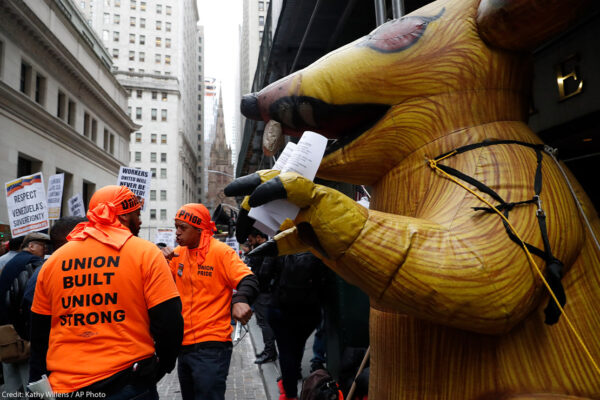Living in New York City, there are some things you just know. You know that if you see a gigantic rat in the subway station you look the other way and pretend it doesn’t exist. And you know that if you see a gigantic inflatable rat in front of a business it means that workers are protesting unfair employer practices.
Scabby the Rat, a 12-foot inflatable rat balloon, is a familiar sight not just in New York but around the country. But the government is now trying to deflate him. Luckily for Scabby, the First Amendment is on his side.
Under existing precedent, unions have a legal right to display Scabby. They cannot be held liable under the National Labor Relations Act (NLRA), the law that governs most private sector employees’ collective bargaining rights, for simply standing with Scabby on a public street. But Peter Robb, the now-fired general counsel of the National Labor Relations Board (NLRB), a government agency, has been on an anti-Scabby mission for years. He has succeeded in bringing the question of whether Scabby is protected by the First Amendment back before the NLRB, prompting the board to invite the public to weigh in. Specifically, the NLRB asked whether it could find that displaying Scabby violates the NLRA without also violating the First Amendment.
It cannot. Since speech about labor disputes is constitutionally protected, particularly when it occurs in public spaces, we filed a brief explaining why the First Amendment protects the giant rat balloon.
Scabby is fully protected symbolic speech. We use symbols all the time to express ourselves, from gestures to black armbands, and Scabby is no different. His presence communicates a clear message to workers, labor unions, and the public: worker dissatisfaction and protest against unfair labor practices.
The government argues that unions and workers have diminished speech rights, and that their criticism of businesses is inherently less protected, because unions advocate the economic interests of workers. But the labor movement and the working conditions it seeks to improve are inherently political, as recently exemplified through the ongoing public debate about the health and safety of essential workers. The Supreme Court has recognized this reality and has repeatedly held that speech touching on working conditions and hiring practices is speech on a matter of public concern — a category of highly protected speech. This is all the more true when the speech is directed at the “public square,” or addressed to a public audience — as it is whenever Scabby appears on public sidewalks.
The government also argues that Scabby deserves no First Amendment protection because he is so scary that his mere presence forces people away from a business and encourages other workers to strike. In the government’s words, “the iconic and menacing rat . . . create[s] an emotional and confrontational barrier” because it is “glaring in character and size and an unmistakable symbol of contempt,” in part thanks to “red eyes, fangs, and claws.” Scabby, the government complains, appeals to “emotions,” rather than “to reason.”But speech does not lose protection because it is emotionally persuasive. And to say that Scabby is coercive is absurd. What the government seems to forget is that Scabby is … a balloon. If anything, the real rats scurrying about in a subway station are much more frightening than the fake, inflatable cartoon outside of it.
Finally, the government tries to analogize Scabby to a union picket line, which the Supreme Court has held may be more strictly regulated than other forms of expression. The government’s argument is yet again absurd. Nobody would confuse a giant rat balloon for a picket line. But the bigger problem is that the Supreme Court’s labor picketing cases no longer make any sense. The Supreme Court has recognized this when it comes to everyone from civil rights picketers to anti-abortion picketers, but it has nevertheless allowed restrictions on labor pickets to stand. For too long, labor speech has been afforded second-class status under the First Amendment. The time has come to reevaluate those decisions, and give labor speech the robust First Amendment protections it deserves.
While it may be fun to make light of defending a gigantic rat balloon, the constitutional implications here are very real. The government is attempting to exterminate Scabby because he is a labor symbol. But the First Amendment protects labor unions just as much as anyone else, and the NLRB should recognize that.

